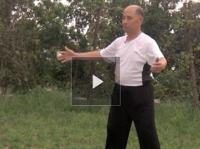While drawing the circle there must be no moving of the body. However, the body must not move. The arm must not be flimsy and must always be constantly pushing down. However, half the energy that goes down must go up. There is an invisible horizontal wall preventing the arm from going down to the ground. This is an abstract wall, and it’s placement is of your own decision and position. The head must be suspended by a string. The head pushes upwards, however, there is an invisible ceiling on top of your head preventing your head from going up. This gives you peng energy.
There are two walls containing the move of the circle. These walls form a 90 degree bracket in which your arm can move inside. However, your arm does not move along the bottom of the bracket to the corner and then go straight up, tracing the boundary of the bracket. This action is called lifting. Your arm should automatically seek the shortcut between the two walls. This can be created by your energy going forward with a twist, with half the energy going down and half the energy going up.
When pushing against a wall, if you push into it head on, it will jam and get stuck. However, if you are one degree off when pushing into the wall and apply a lot of force, it will slide along the wall instead of jamming. Can one consider this movement? If you start on point A and push until you reach and connect to point B, then you have not retreated and only advanced. You are not pushing A, and then stopping to move and push B. It is pushing on the same spot until the push results into a different space. When you catch an opponent with this one degree push, the opponent can not fight back since you are not directly fighting them.
Every move forward has an equal movement backwards.



{ 1 comment… read it below or add one }
Steven, three months after you started doing these circles, you virtually were not the same man as before. These notes helped you on Daqingshan. I hope you will continue to train with these notes by your side. It is those who MOVE ON from these notes that MOVE back in their taiji skills.